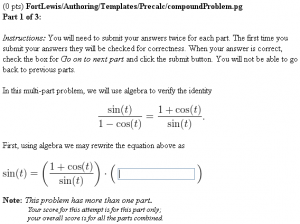ProvingTrigIdentities2
Deprecated: Proving Trig Identites using a Compound Problem
This PG code shows how to have a multi-part question in which each part is revealed sequentially on its own html page. This has been deprecated because of the new scaffold.pl macro that provides the same functionality in a better way.
- File location in OPL: FortLewis/Authoring/Templates/Trig/ProvingTrigIdentities2.pg
| PG problem file | Explanation |
|---|---|
|
Problem tagging: |
|
DOCUMENT(); loadMacros( "PGstandard.pl", "MathObjects.pl", "compoundProblem.pl", "Parser.pl", "PGunion.pl", ); TEXT(beginproblem()); BEGIN_PROBLEM(); |
Initialization:
We use the |
Context("Numeric")->variables->are(t=>"Real");
#
# Redefine the sin(x) to be e^(pi x)
#
Context()->functions->remove("sin");
package NewFunc;
# this next line makes the function a
# function from reals to reals
our @ISA = qw(Parser::Function::numeric);
sub sin {
shift; my $x = shift;
return CORE::exp($x*3.1415926535);
}
package main;
# Add the new functions to the Context
Context()->functions->add(sin=>{class=>'NewFunc',TeX =>'\sin'});
$isProfessor = $studentLogin eq 'professor';
#
# Set up the compound problem object.
#
$cp = new compoundProblem(
parts => 3,
totalAnswers => 3,
parserValues => 1,
allowReset => $isProfessor,
);
$part = $cp->part;
|
Setup: |
if ($part == 1) {
BEGIN_TEXT
${BBOLD}Part 1 of 3:${EBOLD}
$BR
$BR
${BITALIC}Instructions:${EITALIC} You will need to
submit your answers twice for each part. The first
time you submit your answers they will be checked
for correctness. When your answer is correct, check
the box for ${BITALIC}Go on to next part${EITALIC}
and click the submit button. You will not be able
to go back to previous parts.
$BR
$BR
In this multi-part problem, we will use algebra to verify
the identity
$BCENTER
\( \displaystyle \frac{ \sin(t) }{ 1-\cos(t) } = \frac{ 1+\cos(t) }{ \sin(t) }. \)
$ECENTER
$BR
First, using algebra we may rewrite the equation above as
$BR
$BR
\( \displaystyle \sin(t) = \left( \frac{1+\cos(t)}{\sin(t)} \right) \cdot \Big( \)
\{ ans_rule(20) \}
\( \Big) \)
END_TEXT
ANS( Formula("1-cos(t)")->cmp() );
}
|
Part 1: |
if ($part == 2) {
BEGIN_TEXT
${BBOLD}Part 2 of 3:${EBOLD}
$BR
$BR
Step 0:
\(
\displaystyle
\frac{ \sin(t) }{ 1-\cos(t) } = \frac{ 1+\cos(t) }{ \sin(t) }.
\)
$BR
$BR
Step 1:
\( \displaystyle
\sin(t) = \left( \frac{1+\cos(t)}{\sin(t)} \right) \cdot ( 1 - \cos(t) ).
\)
$BR
$HR
$BR
We may use algebra to rewrite the equation from Step 1 as
$BR
$BR
\( \sin(t) \cdot \big( \)
\{ ans_rule(20) \}
\( \big) = \big(1+\cos(t)\big) \cdot \big(1-\cos(t)\big) \).
END_TEXT
ANS( Formula("sin(t)")->cmp() );
}
|
Part 2: |
if ($part == 3) {
BEGIN_TEXT
${BBOLD}Part 3 of 3:${EBOLD}
$BR
$BR
Step 0:
\(
\displaystyle
\frac{ \sin(t) }{ 1-\cos(t) } = \frac{ 1+\cos(t) }{ \sin(t) }.
\)
$BR
$BR
Step 1:
\( \displaystyle
\sin(t) = \left( \frac{1+\cos(t)}{\sin(t)} \right) \cdot ( 1 - \cos(t) ).
\)
$BR
$BR
Step 2:
\( \displaystyle
\sin(t) \sin(t) = (1+\cos(t))(1-\cos(t))
\)
$BR
$HR
$BR
Finally, using algebra we may rewrite the equation from step 2 as
$BR
$BR
\( \sin^2(t) = \)
\{ ans_rule(20) \}
$BR
$BR
which is true since \( \cos^2(t) + \sin^2(t) = 1 \).
Thus, the original identity can be derived
by reversing these steps.
END_TEXT
ANS( Formula("1-(cos(t))^2")->cmp() );
}
END_PROBLEM();
ENDDOCUMENT();
|
Part 3: |
